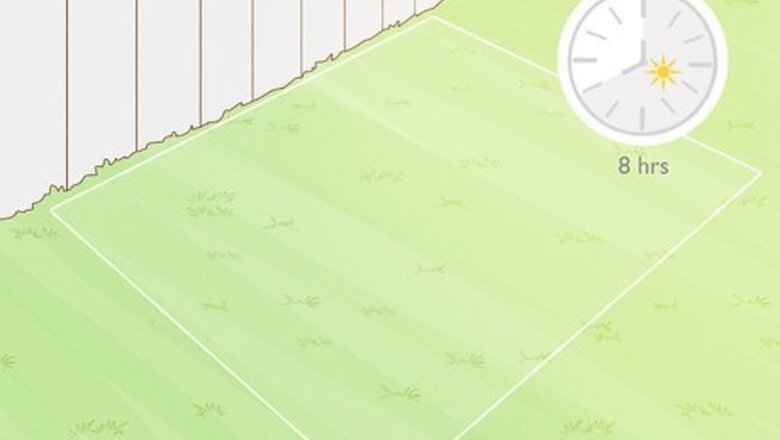
views
Choosing Your Location and Lavender

Choose a well-lit location. Lavender is a Mediterranean herb, so it thrives in hot, sunny locations. Choose a spot in your garden where the plant will receive full sun for at least 8 hours a day. The spot should also be as sheltered as possible to protect the plant from wind.

Make sure the soil has adequate drainage. Dampness is the enemy of lavender, so your most important consideration should be to choose a location where the soil is well-drained. The soil should be light, fluffy and well-aerated for optimum lavender-growing conditions. To improve soil's drainage, you can mix in a little silica sand before planting. Silica sand offers many benefits: it drains well, does not cement, and is very reflective, which helps reflect sunlight onto the plant. This is especially helpful in colder and wetter climates. Alternatively, try planting your lavender on a raised bed, at the top of a slope or beside a wall to maximize drainage. If growing in a pot, consider setting the pot upon a bed of stones or gravel to optimize drainage

Check the pH level of the soil. Lavender grows best in slightly alkaline conditions, with an ideal soil pH level of between 6.7 to 7.3. You can test your soil's pH level using a commercial test probe. These are available for purchase at home improvement stores and garden centers. If necessary, you can increase the alkalinity of your soil by adding a little lime. The amount you add will depend on your type of soil and the test recommendations.
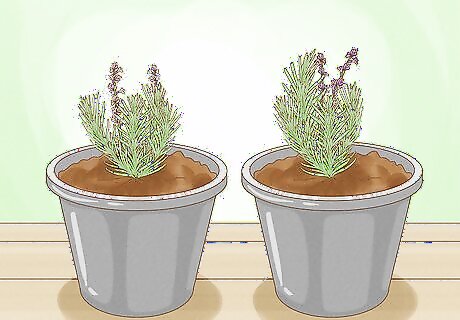
Purchase your lavender. There are many species of lavender available for home growing. Whether they flourish or fail will depend on the conditions in the area in which you live. The types of lavender sold at your local nursery or garden center will usually be compatible with your area's conditions, though you can check the label on the plant or ask a nursery employee if you are unsure. Munstead and Hidcote Lavender are two especially hardy varieties. While it is possible to grow lavender from seeds, this is not recommended as the seeds require scarification and chilling and can take nearly a month to germinate.
Planting Lavender

Water lavender in its nursery pot before planting. You should water the lavender plant in the pot you bought it in, at least an hour before planting. This will ensure that the roots are hydrated, but not damp, before going into the soil.

Dig a hole big enough for the spread roots. Use a trowel to dig a hole in the location you have chosen for your lavender. The hole should just be deep enough and wide enough to contain the roots when you spread them out. If you're planting the lavender in a pot or container, choose a very large pot — the root system for lavender is much larger than the actual plant.

Prepare the soil. Prepare the soil to receive the lavender and optimize its growing conditions by placing two heaped handfuls of 1-inch (2.5-cm) round stone, along with a 1/2 cup (118 mL) total of lime, well-composted manure and bone meal into the hole. Mix well, then cover this blend with a light layer of soil. The stone will help with drainage, the lime will alkalize the soil, while the bone meal and fertilizer will help to get your lavender plant off to a good start.
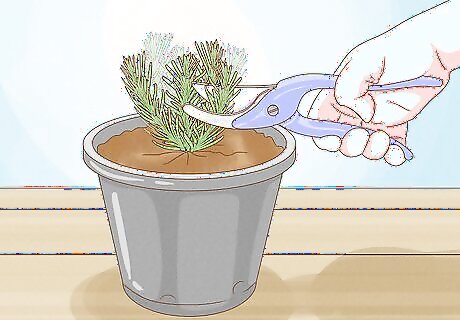
Prune the lavender. Lightly prune your lavender before planting. This will give the plant shape, ensure good air circulation through the stems, encourage new growth, and prevent the center of the stems from becoming woody, which is a common problem with lavender. Good airflow is especially important if you live in a more humid climate.

Prepare the roots. Remove the lavender plant from its nursing pot and gently shake to remove any excess soil from the roots. The lavender should be planted into its new home with bare roots, to ensure it quickly and easily adapts to its new growing environment.

Plant the lavender. Carefully place the lavender plant into its prepared spot and rest it on a layer of soil slightly above the stone blend you mixed earlier. Make sure the roots do not come in direct contact with the blend. Fill in any extra space around and above the lavender's roots with soil, lightly patting it into place around the base of the stems. If you're planting more than one lavender plant, leave about 36 inches (91.4 cm) between each plant. This will guarantee good air circulation and allow the lavender space to grow.
Maintaining Lavender
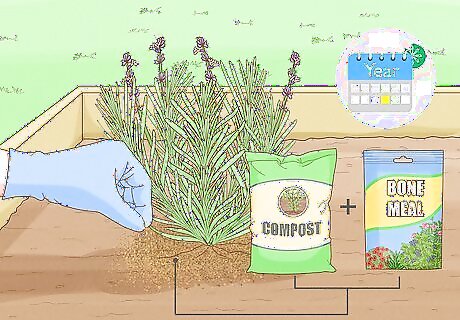
Fertilize the soil once a year. Lavender is a fairly low-maintenance plant and will only need to be fertilized once a year, if that. Use a light top dressing of mixed compost and bone meal, sometime in early spring. An ideal time to fertilize your newly planted lavender is after the first watering. Allow the soil to dry, then apply the fertilizer.
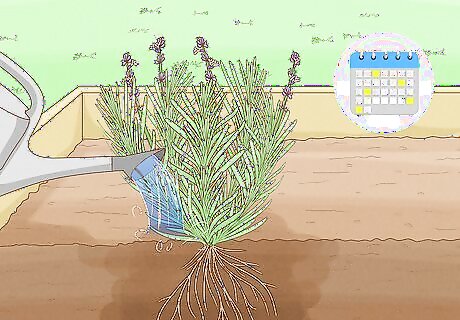
Water sparingly. As mentioned before, dampness is the enemy of lavender and if the roots of the plant become excessively damp, it will kill the plant quicker than any drought or freezing temperatures. In fact, over-watering new lavender plants in spring is the main cause of growth failure. Once the lavender is planted, deeply water it every 7 to 10 days. To achieve the proper level of watering, make sure that the soil dries between each watering; however the plant itself should not be allowed to become dehydrated. If you are growing lavender in a Northern climate, you will water the plant very sparingly until the summer when temperatures can skyrocket and dry out the soil. You will then want to begin watering the plant every 7 to 10 days. If you're growing lavender in a pot, make sure the pot has excellent drainage to prevent water from pooling at the bottom.

Prevent weeds. You can prevent weeds from growing around the base of your lavender plant by covering the soil with a thin layer of mulch. Use a light-colored mulch, such as coarse sand, gravel, or oyster shells. Mulch will also help to protect the plant's roots from winter frosts. Do not use wood mulch, which will retain moisture and can lead to root rot.

Prune the lavender plant. You should prune your lavender plant about once a year, preferably in spring before the new growth begins. You should prune about one third to one half of the plant when it shows new spring growth. Use pruning shears or hedge trimmer to achieve a tidy, rounded shape. New growth looks like long, thin legs sprouting from the leafing branches. The plant will also begin to form blooms. This is also a good time to fertilize the plant. Pruning your lavender will encourage new growth and stop the plant from breaking open and sprawling. Just make sure not to over-prune your lavender as this may kill new growth altogether.

Protect the plant from pests and disease. The two most common pests that affect the lavender plant are whiteflies and spittle bugs. Both can be removed by hand or with a steady stream of water. Check the lavender periodically for reinfestation. Aphids can spread a virus known as the Alfalfa mosaic virus which affects growth and blooming of the plant. Remove any affected foliage and burn it. Be sure to sterilize all gardening tools with disinfectant, chlorine bleach, or isopropyl alcohol to stop the spread of the virus, too.

Harvest the flowers. The best time to harvest fresh lavender is when the bottom flowers of each stem are just beginning to open. This is when the lavender is at its most vibrant and fragrant. Cut the flowers at the base of the stems, near the foliage. Then, Prune the plant back to the new growth leaves. This may encourage your plant to bloom a second time, in the fall. If all or most of the blooms have opened on the lavender plant, then it is too late to harvest for herbal purposes. If you plan to dry the lavender, harvest when about 3/4 of the blooms have opened. If you want to decorate your house with lavender, place the flowers in a vase, but do not put the roots in water. This just causes the flowers to fall off faster and makes the stems mushy.

Dry the lavender, if desired. To dry lavender, bundle about a hundred of the flowers together and tie the bundle with a rubber band. Hang the bundle indoors in a warm, dark and dry location, suspended upside down from a nail, for about 10 to 14 days. If you wish to remove the dried lavender from the woody stems, you can roll the bundle on a metal screen placed over a bucket. This is called "garbling" the lavender.
















Comments
0 comment